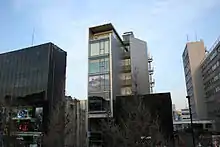Blum & Poe
Blum & Poe is a contemporary art gallery located in Los Angeles, New York, and Tokyo.[1]



Development
Blum & Poe was founded by Tim Blum and Jeff Poe in Santa Monica, California, in September 1994.
The inaugural exhibition in Santa Monica featured Stroke, an installation by British artist Anya Gallaccio, consisting of chocolate smeared onto the gallery walls.[2]
In 2003, Blum & Poe relocated to a 5,000-square-foot warehouse on the edge of Culver City,[3] an area of industrial warehouses. Several other galleries subsequently opened on the same stretch of La Cienega Boulevard, resulting in the formation of the Culver City Art District. [4]
On its 15th anniversary in 2009, the gallery purchased a 22,000-square-foot building across the street on La Cienega Boulevard and renovated it into a series of exhibition spaces on two floors.
Japanese artists
Prior to returning to Los Angeles in 1994, Blum had spent several years living and working in the Tokyo art world. During that time he met Yoshitomo Nara and Takashi Murakami. Blum and Poe visited Murakami's studio in Toyama to see his then newly created Oval Buddha (2007). The massive sculpture was funded through the efforts of the gallerists.[5] Following its opening in Santa Monica, Blum & Poe gave Yoshitomo Nara his first solo exhibition in the United States in 1995. Takashi Murakami’s first solo exhibition with the gallery was in 1997.
In January 2010, Blum & Poe held a solo exhibition of Lee Ufan, the influential Korean artist/theorist of Mono-ha, a loose group of Tokyo-based artists who established themselves in the late 1960s. In February 2012, the gallery held “Requiem for the Sun: The Art of Mono-ha,” the first survey of Mono-ha in the United States, which included major installations by Kōji Enokura, Noriyuki Haraguchi, Susumu Koshimizu, Lee Ufan, Nobuo Sekine, Kishio Suga, Jiro Takamatsu, and Katsurō Yoshida.[6]
In February to May 2019, Blum & Poe Los Angeles hosted the two-part exhibition “Parergon: Japanese Art of the 1980s and 1990s” curated by Mika Yoshitake, which presented the work of over twenty-five visual artists in an array of media spanning painting, sculpture, duration performance, noise, video, and photography. The exhibition title makes reference to the gallery in Tokyo (Gallery Parergon, 1981-1986) that introduced many artists associated with the New Wave phenomenon, its name attributed to Jacques Derrida’s essay from 1979 which questioned the “framework” of art, influential to artists and critics during the period. A catalogue was published alongside the exhibition by Blum & Poe and Skira Editore.
In June 2019, Blum & Poe opened "Vong Co RAHZI", a group exhibition inspired by the influential Japanese visual and music artist 'EYƎ'.[7] It featured a selection of works by EYƎ, known as a pioneer of the Japanese noise genre, and four artists influenced by him. One was Masaho Anotani, who uses his surreal and luminous artworks like a Shaman to communicate what is sacred.[8] There was also Teppei Kaneuji, who re-configures consumer goods for bizarre fantastical sculptures, and the painter of unusual and purposely unrealistic representations of memories, Chihiro Mori.[9][10] The fourth artist was Tomoo Gokita, who presents cultural archetypes with warped and concealed features in grayscale, monochrome, abstract and figurative paintings and drawings.[11]
Korean artists (Dansaekhwa)
Following the 2010 solo exhibition of Lee Ufan and the subsequent survey of Mono-ha in 2012, Blum & Poe expanded its exploration of the artistic contexts in which Lee Ufan worked. In parallel to his involvement with Mono-ha, Lee had been an influential figure to his peers in Korea, whose works were collectively referred to as Dansaekhwa (monochrome painting).
In September 2014, the gallery held "From All Sides: Tansaekhwa on Abstraction," curated by Joan Kee, Associate Professor of History of Art at the University of Michigan, at Blum & Poe in Los Angeles. Featuring Lee and six other core artists from the movement — Chung Sang-Hwa (Chung Sanghwa), Ha Chonghyun, Kwon Young-woo, Park Seobo and Yun Hyong-keun — "From All Sides" was the first major survey of Dansaekhwa to be held in the United States.[12] Blum & Poe in New York subsequently held Ha Chonghyun's first US solo show in November 2014, and Yun Hyong-keun's first posthumous US solo show in November 2015.
Artists currently represented
|
|
|
Branches
On its 20th anniversary in 2014, Blum & Poe established two new branches. In May, the gallery opened a gallery in a townhouse on the Upper East Side in New York. In September, Blum & Poe opened a space opposite the Meiji Shrine gardens in central Tokyo. [13][14]
References
- "Tim Blum & Jeff Poe". ArtReview. ArtReview. Retrieved 10 March 2015.
- "Ninety Pounds of Chocolate Transformed Into Lickable Wallpaper". Boston.com
- Vogel, Carol. "Inside Art: Impressionists Head South." The New York Times. 01 Nov. 2007. Web. 06 Aug. 2014.
- "Interview: Blum & Poe". Art Ltd. LifescapesMedia. Retrieved 10 March 2015.
- Sarah Thornton. Seven Days in the Art World. New York. ISBN 9780393337129. OCLC 489232834.
- "Takashi Murakami's Gallery Ventures Out". The Wall Street Journal. The Wall Street Journal. Retrieved 10 March 2015.
- "EYƎ, Masaho Anotani, Tomoo Gokita, Teppei Kaneuji, Chihiro Mori, Vong Co RAHZI". Blum & Poe.
- "Masaho Anotani". SHDW.
- "Teppei Kaneuji". Jane Lombard Gallery.
- "Chihiro Mori". Chihiro Mori website.
- Irwin, Michael. "Tomoo Gokita | Artist Profile". Ocula.
- "artnet Asks: K Auction on the Market's Dansaekhwa Moment". artnet News. 2016-05-18. Retrieved 2019-05-09.
- "Blum & Poe gets closer to its artists". The Japan Times. The Japan Times. Retrieved 10 March 2015.
- Ng, David. "Blum & Poe Opening Tokyo Office to Strengthen Ties with Asia." Los Angeles Times. 03 Oct. 2012. Web. 06 Aug. 2014.